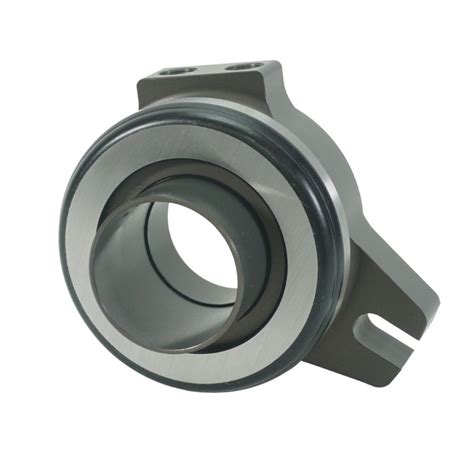Hydraulic Bearings: A Comprehensive Guide
Understanding Hydraulic Bearings
A hydraulic bearing is a type of bearing that uses fluid (usually oil) to separate the moving parts and support the load. This fluid film provides a cushion between the surfaces, reducing friction and wear.
Hydraulic bearings are often used in high-speed and heavy-load applications where traditional bearings may fail. They are commonly found in:
- Industrial machinery
- Aerospace components
- Automotive transmissions
- Medical devices
Types of Hydraulic Bearings
There are several types of hydraulic bearings, classified based on their design and application:
Journal bearings: Support a rotating shaft in a stationary housing.
Thrust bearings: Support an axial load, where the force is applied perpendicular to the shaft.
Radial bearings: Support a radial load, where the force is applied parallel to the shaft.

Advantages of Hydraulic Bearings
Hydraulic bearings offer several advantages over traditional bearings, including:
-
Reduced friction: The fluid film eliminates metal-to-metal contact, reducing friction and heat generation.
-
Improved load capacity: The fluid film distributes the load more evenly, increasing the bearing's load-carrying capacity.
-
Longer lifespan: The absence of metal-to-metal contact reduces wear and tear, extending the bearing's lifespan.
-
High-speed operation: Hydraulic bearings can operate at very high speeds, making them suitable for demanding applications.
-
Shock and vibration absorption: The fluid film absorbs shock and vibration, protecting sensitive components.
Design Considerations for Hydraulic Bearings
The design of a hydraulic bearing is critical to its performance. Some key considerations include:

-
Fluid type: The choice of fluid is crucial for its viscosity, temperature stability, and compatibility with the materials.
-
Bearing clearance: The clearance between the bearing surfaces affects the fluid flow and film thickness.
-
Bearing shape: The shape of the bearing surfaces influences the pressure distribution and load capacity.
-
Material selection: The materials used for the bearing surfaces and housing must withstand the operating conditions and loads.
Manufacturing Processes for Hydraulic Bearings
Hydraulic bearings are typically manufactured using precision machining and grinding techniques to achieve high dimensional accuracy. The process involves:

- Precision machining of the bearing surfaces
- Grinding to create the desired shape and surface finish
- Assembling the bearing components
- Testing and inspection to ensure performance meets specifications
Applications of Hydraulic Bearings
Hydraulic bearings are widely used in various industries, including:
-
Industrial machinery: Machine tools, pumps, compressors, and other high-performance equipment
-
Aerospace components: Jet engines, flight control systems, and landing gear
-
Automotive transmissions: Manual and automatic transmissions, differentials, and final drives
-
Medical devices: Surgical tools, implants, and imaging equipment
Maintenance and Troubleshooting of Hydraulic Bearings
Maintaining hydraulic bearings is essential for optimal performance and longevity. Regular maintenance includes:
- Monitoring fluid levels and condition
- Checking for leaks, contamination, or vibration
- Replacing worn or damaged components
Troubleshooting common problems can help identify and resolve issues quickly:
-
Overheating: Caused by excessive load, insufficient lubrication, or contamination
-
Noise: Caused by cavitation, misalignment, or bearing wear
-
Leaking: Caused by damaged seals, loose fittings, or excessive pressure
Strategies for Effective Hydraulic Bearing Operation
To ensure efficient and reliable operation of hydraulic bearings, consider the following strategies:
- Use high-quality fluids and lubricants
- Monitor bearing temperatures and vibration levels
- Perform regular inspections and maintenance
- Replace worn or damaged components promptly
- Consult with experts for complex maintenance or troubleshooting
Tips and Tricks for Hydraulic Bearing Success
- Use a high-viscosity fluid to increase load capacity but reduce speed.
- Reduce the bearing clearance to increase stiffness but limit flow and decrease speed.
- Optimize the bearing shape to distribute pressure evenly and improve load capacity.
- Use exotic materials like ceramics or composites to enhance durability and performance.
Humorous Stories and Lessons Learned
- A new engineer once installed a hydraulic bearing upside down, leading to catastrophic failure and a memorable lesson on the importance of attention to detail.
- A maintenance technician spent hours trying to diagnose a noisy bearing, only to discover a loose bolt that was causing the vibration. The lesson: always check the simplest things first.
- A team of engineers designed a hydraulic bearing system that performed perfectly in the lab but failed miserably in the field. They later realized they had not accounted for real-world operating conditions, highlighting the need for thorough testing and simulations.
Pros and Cons of Hydraulic Bearings
Pros:
- Low friction
- High load capacity
- Extended lifespan
- High-speed operation
- Shock and vibration absorption
Cons:

- More complex to design and manufacture than traditional bearings
- Require a constant supply of fluid
- Can be sensitive to contamination
- May generate noise if not properly designed
Frequently Asked Questions (FAQs)
Q: What is the difference between hydrostatic and hydrodynamic bearings?
A: Hydrostatic bearings use an external pump to generate the fluid film, while hydrodynamic bearings rely on the rotating motion of the shaft to create the fluid film.
Q: How do I choose the right hydraulic bearing for my application?
A: Consider factors such as load capacity, speed, operating environment, and maintenance requirements. Consult with a bearing manufacturer or expert for guidance.
Q: What are the common materials used for hydraulic bearings?
A: Common materials include steel, bronze, aluminum, and ceramic. The choice depends on the specific application and requirements.
Q: How often should I inspect and maintain hydraulic bearings?
A: The frequency depends on the operating conditions. Regular inspections should include checking fluid levels, monitoring temperatures, and listening for unusual noises.
Q: Can hydraulic bearings be used in vacuum environments?
A: Special types of hydraulic bearings, known as vacuum bearings, are designed specifically for vacuum applications.
Q: How do I troubleshoot noise in hydraulic bearings?
A: Check for leaks, misalignment, bearing wear, or contamination. The source of the noise can help identify the underlying problem.

